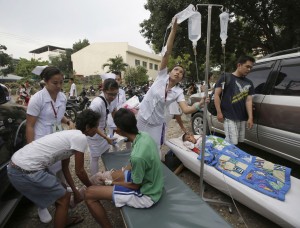Phivolcs tells public: Expect aftershocks, but don’t panic

FILE PHOTO
MANILA, Philippines — The Philippine Institute of Volcanology and Seismology (Phivolcs) has advised residents of Visayas and Mindanao to expect aftershocks in the coming weeks from Tuesday’s magnitude 7.2 earthquake but has also explained that the aftershocks will be of less magnitude and should not be a cause of panic.
The agency added on Wednesday that it has deployed two teams to Bohol and Cebu Provinces to conduct an information campaign and a hazard assessment in the aftermath of the powerful temblor.
“These (aftershocks) are normal events after a major earthquake. A person might be alarmed or overwhelmed by the number of aftershocks we record but a lot of them are only detected by our instruments and they are too slight to be felt by people,” Phivolcs director Renato Solidum told the Philippine Daily Inquirer, adding that in the case of an aftershock, people should stay calm.
Solidum said the aftershocks would likely continue for weeks as has usually been the case with major earthquakes.
“It is like when the driver of a car suddenly hits the brakes. The car continues to move before it makes a full stop,” he explained, adding that the aftershocks would eventually dwindle in frequency.
Article continues after this advertisementIn the Phivolcs’ Earthquake Preparedness Guide, it advises primarily for people to stay calm and for those within structurally sound buildings or homes to stay indoors and duck under a sturdy desk or protect their heads with their arms to remain safe from falling objects. People are also advised to stay away from glass windows, shelves, closets and other heavy objects.
Article continues after this advertisementIf outside, the guide suggests that people move to an open area away from trees, power lines and concrete structures and to stay away from steep slopes, which may be affected by landslides. If near the seashore, particularly during a strong earthquake, people are advised to move quickly to higher ground as the tremor might trigger a tsunami. A person inside a moving vehicle is to stop and get off. The guide says it is not advisable to cross a bridge, overpass or flyover as it may already have been damaged.
Following the magnitude 7.9 earthquake which hit Luzon on July 16, 1990, Phivolcs recorded aftershocks for a year, listing down at least 20,000 aftershocks from the powerful quake, although most of them were hardly felt and were only detected by instruments.
As of noon Wednesday, the Phivolcs recorded 869 aftershocks from the magnitude 7.2 Bohol quake. Out of that number, only 15 were felt, the strongest of which were two magnitude 5.1 tremors.
The first happened at around 9:36 a.m. Wednesday with its epicenter at 34 kilometers northwest of Tagbilaran City with a depth of focus at 10 kilometers. The aftershock was felt at Intensity IV in Sibulan town, Negros Oriental and Tagbilaran City, and felt at Intensities III and II, respectively in Lapu-Lapu City and Mambajao, Camiguin.
An hour later, at 10:42 am, another magnitude 5.1 quake struck, 57 kilometers northeast of Tagbilaran City with a depth of 12 kilometers. The earthquake was felt at Intensity V in Lapu-Lapu City; intensity III in Sibulan, Negros Oriental; and Intensity II in Iloilo and Ormoc Cities.
Earthquakes felt at Intensity II mean people on the upper floors of a building would feel the movement. Intensity III means many people indoors feel the shaking and hanging objects will sway, but people outside hardly feel any movement. Intensity IV means almost all people indoors feel the shaking and the rattling of objects is visible. Some people outside might feel the movement and some parked cars would rock.
Meanwhile, two Phivolcs teams were deployed to Bohol and Cebu Provinces to document events and help the local government units allay the fears of residents in their areas.
Solidum said that the first team was dispatched on Tuesday to conduct an information campaign in the affected provinces and to assist the local governments in explaining to the public what should be done before, during and after an earthquake.
The second team left Wednesday for the provinces to document the effects of the major earthquake and to conduct studies on the events after the powerful tremor. He told the Philippine Daily Inquirer that the second team would have to make a hazard assessment as there might be a need to update the information following the major earthquake.
RELATED STORIES:
Bohol earthquake strongest to hit Visayas and Mindanao in over 20 years
Netizens post scenes from Bohol quake
Death toll in Bohol quake now close to 100